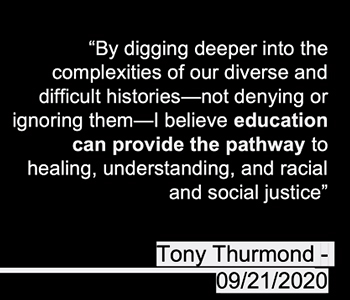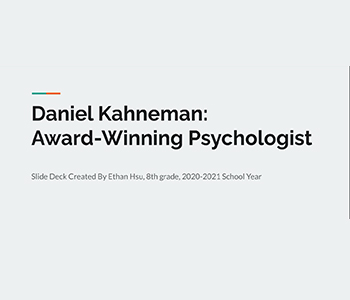Teaching Diversity with the Lives of Scientists
By Fidela Robertson and Shay Fairchild, CASE Treasurer
Introduction
Racial justice is a renewed cry in our society. Major organizations have pledged to make equity an integral part of their mission statement. In the Los Angeles Times, 6 October 2020, the owner, Patrick Soon-Shiong, wrote: “We are committed to change, both because it is just and because it is mission-critical for our business.” More people of color and news about neighborhoods of color are being recognized by the Los Angeles Times. The Los Angeles Times is becoming self-aware.
Schools are within neighborhoods, and districts must recognize inequity, in order to truly provide the resources that are needed for children to achieve, to dream and to make those dreams come true. Social-emotional Learning is a major focus in our district and in the state of California. A recent article, “Why we can’t afford white-washed social-emotional learning” (ASCD Education Update, April 2019), reports that self-awareness deepens when students are given activities to reflect on their identity and on equity.

Equity is integral to our work. When we provide students with a curriculum that includes people and multiple cultures, students will grow in self-acceptance and acceptance of others. This can be done within the content area, but we must be aware of opportunities that beckon us to use these serendipitous opportunities with intentionality. This requires flexibility on the part of the teacher.
Opportunities to highlight the diversity of scientists and the diversity of the scientific endeavor is one way to open the eyes of children to see themselves in scientists. Teachers must also have their eyes open to see what is there and what needs to be there.
Lesson – Self-awareness through the content
I was looking for something fresh to engage my students in the world of science to begin the year. I found a short article in LabXchange, “Ordinary Folks Doing Extraordinary Things”, by David Denlinger, PhD and Medical Entomologist.
Begin with reading the article
Students accessed the article through Schoology and annotated it. We discussed the article in the Zoom class. There was nothing particularly Earth-shaking in the discussion.
Students chose a scientist from links that I provided to them
In the following Zoom class, students were given time to explore the links that I provided: female scientists from around the world, influential African-American scientists, 21st century scientists by nationality, and finally a list of great scientists who are in the textbooks. Students sent me a document stating the name of the scientist of their choice, and why they chose that scientist. (The links are in the “Reference” at the end of the article.)
Students given a rubric to create a Google slide of the scientist and report to the class via Zoom
The Google slides varied in depth; some were quite good and others average. Every student completed the assignment. The students gave an oral presentation, and the listeners took notes: name of student presenter; name of scientist; a major accomplishment of the scientist. After the presentation, a listener was called upon to give feedback following the notes they took. I was generally pleased with what I saw the students write in their notebooks.
Student feedback
Here are some examples of what students wrote:
“I chose Yu Myeong-Hee. I chose her because I really wanted to lean [in] into the diversity of science, so choosing a female scientist from a country almost on the other side of the globe seemed fit.” (male, Hispanic)
“The scientist[s] I have chosen is Velma Scantleburry*. The reason I chose her is because she was the first African American woman transplant surgeon and that really caught my interest.” (female, Hispanic)
“For my Scientist I chose Sue Black. The reason I chose her is because I wanted to choose a computer scientist. The reason for this is because I have done computer science before. I wanted to choose a woman from another country. This is because my whole life I have been writing about men from America. I think that it would be interesting to do something new like this with a different objective and to learn new knowledge.” (male, Caucasian)
Student sample
I asked one student to make his Google slide presentation more dynamic. I include it here (double click on the slide):
Scientists are people
One of the prompts was to find out what obstacles the scientist had to overcome: students learned about racial prejudice, gender bias, scientific bias (Galen v. Harvey), poverty, illness, character assassination (Rachel Carson), and murder (Dian Fossey). The students were moved by what they learned about so many different scientists. We all have struggles. They learned how scientists overcame or lived with the struggles they encountered.
Conclusion
I learned how open students are to people who are different from themselves, and how varied student interest is in different fields of science. This activity gave students an opportunity to learn about a scientist of their choice from a different part of the United States, or from a different country or culture, and a different scientific focus. Teaching diversity through the lives of scientists is a way to deepen self-awareness in students and to develop an appreciation for others who are different.
References
Below is a very small set of the scientists that the students reported on.
| Scientist | Field of Study | Country of Origin | Major Accomplishment | Date of Birth | Date of Death |
|---|---|---|---|---|---|
| Linda B. Buck | Biologist | United States | She was a Nobel prize winner | 6/29/1947 | not deceased |
| Jane Goodall | Primatologist and anthropologis | England | Studied and was with chimpanzees for 60 years. | 04/03/1934 |
not deceased |
| María Teresa Ruiz | Astronomy | Chile | Mrs. Ruiz discovered Kelu-1, a system of two brown dwarfs of spectral types L2 and L4. | 09/24/1946 | not deceased |
| Lydia Kavraki | Computer Science | Greece | concepts of robot motion. She also won the ACM Grace Hopper award for outstanding computer scientist of the year. | 1967 | not deceased |
| Warren M Washington | Meteorologist and atmospheric | African American | Award for national medical of science for physical science | 8/28/1936 | not deceased |
| William Harvey | Physician | England | Harvey’s greatest achievement was to recognize that the blood flows rapidly around the human body, being pumped through a single system of arteries and vein. | April 1, 1578 | June 3, 1657 |
| Robert Oppenheimer | Atomic research | United States | Considered the maker of the first atomic bomb. | 04/22/1904 | 2/18/1957 |
| Carl Sagan | Astronomy Astrophysics Cosmology Astrobiology Space science Planetary science | United States | He has a Tv show and he has won a medal also he has wrote his own book | November 9, 1934 | April 1995 |
Below are links to African-American scientists, female scientists, scientists from around the world and a classical list of scientists that I provided to students.
- List of female scientists in the 21st century
- 31 Highly Influential African American Scientists
- 21st-century scientists by nationality
Students could also choose a more well-known scientist from the list below:
- William Harvey
- Marie Curie
- Charles Richard Drew
- Rachel Carlson
- Sir Isaac Newton
- Albert Einstein
- Dian Fossey
- Jane Goodall
David Denlinger’s article, “Ordinary Folks doing Extraordinary Things”is available in LabXchange; he is a Medical Entomologist and has a Ph.D.
Fidela Robertson teaches middle school science and Shay Fairchild is a district instructional coach in Southern California.






